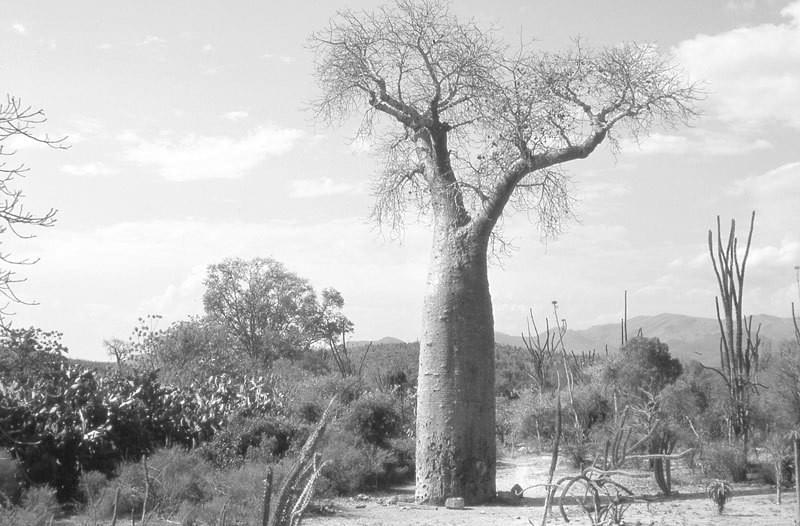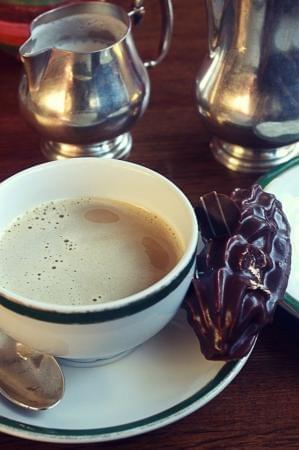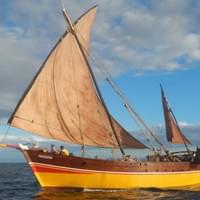
- Home
- About Cowgirls & Pirates
- The Baraza Blog
- Recommended Reading, Logistics
- Giving Back
- Great MIgration

Madagascar
World Out of Time
Africa's Shangri-La
Musicians Henry Kaiser and David Lindley titled their Malagasy music CD "A World Out of Time." The world's fourth-largest island, Madagascar broke off from the super-continent Pangea more than 100 million years ago. In isolation from the rest of the world, species proliferated wildly: 8,000 animal species found nowhere else on earth.
Less well-known are Madagascar's amenities, which made it one of CNN's top 16 emerging destinations: music, architecture, charm - and extraordinary food. In that way, too, not much has changed since the 1800s, when French poet Baudelaire penned the lines "luxe, calme, et volupté" about Madagascar.
There are so many places to go, all utterly unique. We love the 12-day trip to both rainforest and the island's unique spiny forest. Take the time to explore....
After all, it's not every day you travel to another world.
Three Trips with Variations
12 days: Madagascar's Greatest Hits
18 days: Way Out West
Mix and Match
Tips on Logistics
Tip #1: While French pastry is first-quality, Madagascar's transportation infrastructure is not. For 2-week trips, air travel is a must, and even then, Air Madagascar, the national airline, can throw a monkey wrench into your trip by rescheduling flights without much notice. Our itineraries are designed to eliminate unforeseen delays and to take into account Madagascar's rough roads.
Tip #2: A great naturalist guide makes all the difference, particularly if he also knows Madagascar's best out-of-the-way French restaurants. We strongly recommend including a private guide on your trip. We partner with the country's best, including our old friend Gerard Ravalojanahary, the man other guides call "elder brother."
Madagascar's Greatest Hits
12 days

Hotel Sakamanga
2 nights/Antananarivo's hippest hotel
Days 1 & 2
Arrive Day 1: Airport pickup by driver/guide. Driver will be at your disposal during your time in Antananarivo, called Tana for short. Dinner on your own. (We recommend the Sakamanga's restaurant.)
Day 2
Meet with scientist/conservationist from Vahatra, Malagasy group. Introduction to land and people. Lunch at one of Madagascar's superb restaurants. Pick up any necessaries that you forgot to pack with driver accompanying you.

Rainforest and Sea*
Manafiafy Camp
Days 3-7
Fly into Fort Dauphin and drive 2.5 hours to a solar-powered eco-lodge in a lush coastal rainforest. (Charter flights available depending on days of travel.) Collared Brown, Southern Woolly, Thick-tailed Dwarf, Brown Mouse and Sportive lemurs can be seen on day and night walks. Humpback whales ply the coastal waters from June until November.
alternate:
Want a more remote rainforest experience? We also recommend traveling to Masoala National Park, where you can stay at an eco-lodge accessible only by boat or stay at Tampolo Eco-Lodge at Maroanasetra and visit Nosy Mangabe, the island "bursting with wildlife" including the aye-aye, released here in the 1960s to head off what was thought to be their imminent extinction.

Spiny Forest
Mandrare River Camp
Days 7-11
Drive or fly via charter to a an eco-lodge in Madagascar's most unique landscape. The World Wildlife Fund named Madagascar's spiny forest one of its Global 200 priorities for conservation. In this other-worldly landscape 95% of the original flora is endemic, meaning it exists nowhere else. Erratic rainfall and poor soils have spurred the evolution of cacti-like plants and exceedingly rare species such as the radiated tortoise. Only 3% of the spiny forest is protected, so your visit encourages surrounding communities to preserve this remarkable place.
For Birders: Instead of Maniafafy Rainforest (above) head straight for Mandrare River Camp, and after 3 days, visit the ‘transitional forest’ of Zombitse National Park, known for sightings of the Appert’s greenbul, giant and crested couas, recently described olive-capped coua, and blue, sicklebill, hook-billed, rufous, white-headed, and Chabert’s vangas. Top it off with a 2-night stay at Andasibe National Park, home of the indri-indri, and a rainforest thought to contain the highest density of frogs on earth.

Tana Redux
Hotel Sakamanga
Days 11-12
Overnight in Tana and after espresso and a pastry at the Patisserie Colbert, spend a final day visiting Akany Avoko, a unique school for girls who found themselves in trouble with the law. Started by an English hippie and his formidable Malagasy wife, the school is more than an educational institution; it's an inspiration. Last-minute shopping? Your driver is happy to oblige. Included for all visitors is our Insider's Guide to Madagascar.
Way Out West
18 days

Isalo National Park
The Crown Jewel of Madagascar's Park System
Isalo is big desert wilderness. Canyons cut through sandstone, rare and endemic plants grow in sandy cracks, and dry weather makes Isalo a year-round destination with rare plants like pachypodium, as well as lemurs: sifakas, brown lemurs, and ring-tails. Your most memorable moment may be when your guide points out ancient burial sites in caves slotted into canyon walls.

La Piscine, Isalo
Way Out West Itinerary
Days 1 & 2 Antananarivo
Days 3-6
Drive to Isalo Rock Lodge, spend 2 days hiking in Isalo National Park with your guide.
Days 6-11
Travel by 4x4 to see the Mikea, Madagascar's last hunter gatherers, and from there to the Beza-Mahafaly Special Reserve where two kinds of forests, spiny and riverine (popularly known as "gallery forest") yield unparalleled opportunities to see Madagascar's four species of tenrec, a creature that resembles a hedgehog and subsists on termites - plus Madagascar’s only serious predator, the fossa, a relative of the mongoose that can reach up to six feet in length.
Meet scientific researchers and learn about their work. A night walk in the gallery forest offers a chance to see sportive and mouse lemurs. Along the way, we stop at Ilikaka, the sapphire mining town that recalls a Salgado photograph - or a Western gold rush town. Camping and bungalows.
Days 12-16
No trip to Madagascar is complete without time on the Indian Ocean. Staying at Laguna Blu Lodge, we visit with Blue Ventures, lauded as one of the world's most successful community conservation efforts.
Day 17 Fly from Ft. Daupin to Tana and overnight at Sakamanga Hotel.
Mix and Match
The Tsingy
Beaches

The Tsingy, 230 square miles of eroded limestone wilderness, is home to 11 species of lemur. Hikes vary in difficulty and are led by park-approved guides. Fly to Morondave, overnight at Chez Maggie, drive to the Soleil de Tsingy Hotel, reasonably priced luxury with excellent food, great views, and an infinity pool.
Park: April-November; closed during rainy season
Grand Tsingy: June to beginning of November
Madagascar's Beaches
Ile St. Marie or Nosy Be?
paradise or paradise?
(quite a conundrum)
Madagascar's beaches aren't just beautiful. They'll change your definition of the word beach. (Sports Illustrated shot their 2015 swimsuit issue here, and the models seemed to agree.)
Ile St. Marie, where the Pirates Cemetery is perched high on a bluff, and its smaller neighbor, Ile aux Nattes, are special, low-key islands on Madagascar's east coast. Nosy Be, on the west coast, has reliably good weather, and we recommend getting out on the water....
Sailing and Camping with Alefa
We can't rave enough about the Indian Ocean, or about the truly cosmopolitan experience one can have in Nosy Be, renowned as the haunt of retired French gangsters, but in reality home to an international expat community that has adopted the island's slogan "mora, mora" - the Malagasy version of mañana. The lack of racial tension in Madagascar is uplifting for anyone who travels there. We highly recommend sailing and camping with the sailing company Alefa out of Nosy Be. The company is owned by the scion of an old French family and he is so modest that he does not include his picture among the staff. Both he and his Malagasy crew know the coast as intimately as we know our own home. Trips run 4-12 days, and they are all-inclusive. Enjoy swimming, snorkeling and spearfishing on pristine coral reefs.
You'll feel like just Robinson Crusoe, only with sushi and cocktails.
Mora, mora. (The Malagasy version of "mañana.")
To contact us, fill out the form below.
No hard sell. Ever.
Why Madagascar
"… Madagascar tells us which rules would still hold true if time had once broken its banks and flowed to the present down a different channel …"
Alison Jolly

illustration of extinct Malagasy species: elephant bird and pygmy hippopotamus
Why We love Madagascar: Tiny Animals
“….tracking lemurs offers something different, perhaps an even more intimate, delicate view of nature…”
Jeffrey Gettleman, New York Times
Ninety percent of the plants and animals found on the island of Madagascar evolved there and nowhere else. All of the country's 70-plus species of lemur are considered endangered. To help protect them and other unique species, the government has set aside more than nine million acres of land.
National Geographic
From 1999 to 2010, scientists discovered 615 new species in Madagascar, including 41 mammals and 61 reptiles.
World Wildlife Fund
Our Connection to Madagascar
“Few places in the world have more natural resources than Madagascar and few places are easier to exploit.”
Steve Goodman
Susan's story
I landed in Madagascar in 2001, training environmental journalists as a Sen. John Heinz Fellow under the umbrella of the Washington, D.C. Center for International Journalists. I taught a class in the rainforest of Ramanofana National Park, spent 10 days paddling on the Mangoky River, climbed aboard a replica of an antique dhow to sail, snorkel, and camp around Nosy Iranja and other marvels of the Indian Ocean, and spent a rainy, memorable week on Ile Aux Nattes and Ile St. Marie, where I let a small boy take me to the island's Pirate's Cemetery on a misty afternoon.
I came to appreciate the seamless grace that links Malagasy culture with the nature surrounding it. Humans arrived on the island 2,000 years ago, and while their incursion resulted in the extinction of unique creatures - the elephant bird and the pygmy hippopotamus pictured above by an artist in 1598 - the people and landscape are of a piece.
I quickly discovered that my role was not to teach, but to exchange information with fellow professionals. That spirit of equal exchange - and the excitement that comes with it - is at the heart of Cowgirls & Pirates.
I could not be more thrilled to be partnering with Steve Goodman ("the Michael Jordan of field biology") whose organization, Vahatra, has trained hundreds of Malagasy scientists to study the island's many one-of-a-kind species. Vahatra is the recipient of our 1 % for the Planet donations from our Madagascar trips.
Steve Goodman of the Field Museum and Vahatra
The Dirtbag Scientist
Fearless and brilliant, with 12 species named after him, Macarthur award-winner Steve Goodman has ensured that generations of young Malagasy biologists will be trained to protect the island's biodiversity..

Copyright 2025 Cowgirls & Pirates
















